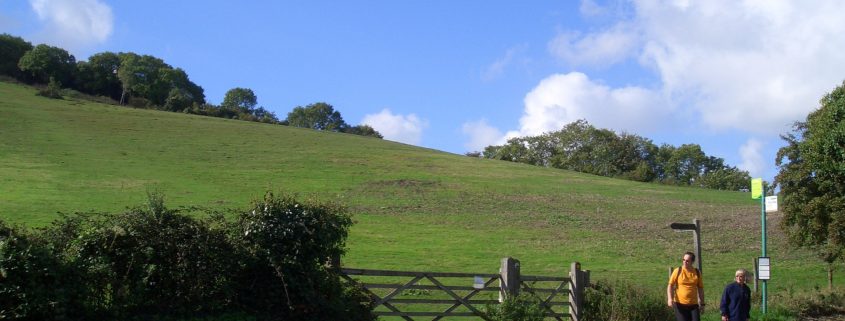
Nansen Hill
Nansen Hill is at the eastern end of the Ventnor Downs, between Bonchurch and Luccombe. It is on the west side of the A3055 Shanklin to Ventnor road.
The reserve is a very steep grassy slope with spectacular views out over the English Channel and Sandown Bay. It is nationally protected for the great populations of chalk grassland flowers and insects that are found there, especially orchids and butterflies.
Nansen Hill as a place for recreation goes back to 31st December 1932. Mr John Howard Whitehouse, the Warden of Bembridge School, conveyed the central part of the hill to four distinguished men – the Prime Minister of Britain (Ramsey McDonald), the Prime Minister of Norway, the Rector of Oslo University and a Mr Neil Rocke from London.

The moment Mr Whitehouse handed over the deeds of Nansen Hill to Lord Cecil on 31 December 1932. The present-day road to Cowlease is visible in the background.
A trust was established enabling the land (held by these persons as trustees) to be used for “the result of recreation of adults, children and in particular the youth of England and Norway” in memory of Dr Fridtjof Nansen who had promoted “peace and friendship” between the nations.”. Later, in 1963, the land adjacent to the road was added when it was conveyed to the County Council by the Education Trust Ltd.
What to look and listen for…
This site has fantastic views that stretch from Culver in the East, pass Red Cliff, Sandown Town and Pier, upper Shanklin and down to Luccombe shore. In the channel spot ships and ferries, sometimes they anchor in Sandown Bay, waiting for dock space, or sheltering in a storm. The birds hover on wind currents – often below you.
The site has chalk grassland, with the richest areas botanically being the middle and upper parts of the slope where the turf is shorter. Characteristic plants occurring throughout include yellow-wort, glaucous sedge, dwarf thistle, eyebright, hoary plantain, and salad burnet. There is a good population of autumn gentian in most years at the top of the slope. Devil’s-bit scabious is also found towards the north of this area. On the terracettes on the north-facing slope at the top, there is a population of common spotted orchids. It is part of the Ventnor Downs Site of Special Scientific Interest.
Although we manage Nansen Hill for the chalk flora and fauna, we let some scrub grow too, as it’s very important for birds. You will probably hear more bird song from the scrub than from the open land. Try bird song identification – the Dartford Warbler sits atop the gorse and has a rattle scratchy song, the Linnet is more melodious, and the Yellowhammer is famous for its ‘a little bit of bread and no cheese’ song,
… and smell and touch
Smell the coconut fragrance of gorse and the sweet-scented pink or white flowers of the Dog Rose that appear in June and July,. The highly perfumed flowers of the Common Spotted Orchid are particularly attractive if you are a day-flying moth.
Bilberries and Rosehips can be collected in the autumn for jam but leave some for the birds. Feel the spiky teasels – the seeds are very important for birds, such as the goldfinch, which can often be seen alighting on the old, brown flower heads in autumn to ‘tease’ the seeds from them.
Nature at home and activities on site
We have produced a super Colouring Sheet for you to download and complete at home. We have also produced an I Spy Sheet and Map for you to print at home, or download to your phone and take to the site. And become a Bug Bunch Ranger. All these activities and resources can be found here.
Managing the site
In 2018 thanks to the funds from the Heritage Lottery from Down to the Coast we made some long-awaited improvements to Nansen Hill that made it safer and easier to get onto the site, but also helped cattle to graze which is great for the wild flowers and butterflies that depend on the delicate chalk grassland. Ypu might find cattle on the site – they wander in from the surrounding National Trust land, so please keep your dogs on leads.
Our volunteers also help to keep scrub in check in the Autumn.
How to get there
On foot – Footpaths V109 and V123 cross the site and link it to the adjoining Bonchurch Down.
By bus, car and bike – There is no access by road. There is a road closure to the north from Shanklin and southwards at the junction of Leeson Road and Bonchurch Shute. There is no access to the site car park from either direction.
what3words for car park ///slips.player.shadowing
Access
Grass paths cross the site which is steeply sloping. There is relatively flat access from the road to the site but the site is entered through a kissing gate which is 1.2 metres wide. There is a Information Pillar at this point. The site information pillar has a QR code that links to an audible description creating a mind’s eye view of the area to allow a visually impaired person to enter with confidence. The information pillar also has a QR code that links to a map and activities. There is also a site map on the Information Pillar. It is not suitable for mobility scooters.
The nearest public toilets are in the town of Ventnor.
We have written an Access Statement for this site. This includes mobility and sensory issues and opportunities. We welcome feedback from users.

We have produced an audible description creating a mind’s eye view of the area to allow a visually impaired person to enter with confidence. It will describe the entrance, the size of the area, where to find further information or help and any major obstacles or features. Information has been produced by visually impaired people ensuring it is useful and accurate. Access the description by scanning the QR code to the left of this text on your phone or tablet, or by clicking here.
Get Involved
There are various ways you can help improve and maintain our sites. We rely on volunteers to help with many tasks on our sites and also need people who are happy to regular visit the site be our “eyes and ears”, this means we can respond much quicker to issues. Our shop raises money to support our work and needs a team of volunteers. Or maybe you would like to help us with events. Find out more here.
You can also help by becoming one of our regular supporters. Even giving a few pounds each month can make a real difference, with your donation being invested into site management and improvement work to benefit site visitors and look after our precious wildlife. Sign up here.
